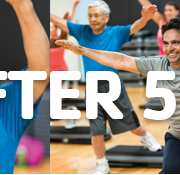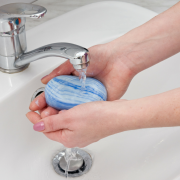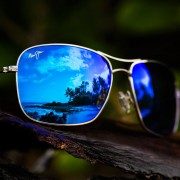Don’t Put Your Sunglasses Away With Your Summer Clothes!
Have you ever thought, “Hey, it’s cold and snowy, the sun must not be as intense”? You might be surprised to find out that this is not the case. In fact, although most people associate it with summertime, sun protection for your eyes may be even more important during the winter months
during the winter months
The people at highest risk for sun related problems include: children, outdoor workers, and snow sports enthusiasts because they tend to spend longer hours outdoors and in conditions that create the most exposure to ultraviolet radiated light. While everyone should take the proper precautions, there are special considerations that can be taken depending on your risk factors. Take a look at the facts and tips below to find out why using high quality sunglasses in the winter could be some of the best protection you can give your eyes.
Important for Parents:
- Exposure to ultraviolet radiation in childhood may be more damaging than exposure in adulthood. It is cumulative, as it is to skin.
- Children’s eyes need to be protected. They are more prone to sun damage because their natural lenses are clearer.
- Wearing sunscreen on the face and around the eyes adds another layer of protection against ultraviolet radiated light.
- It is important for parents to understand the danger of ultraviolet light, and the importance of protecting children’s eyes now, when it will offer the most benefit. Polycarbonate and Trivex lens materials offer built-in ultraviolet protection. Trivex lenses offer the added benefit of being the most shatter-proof lens on the market today. Even if a child does not require a prescription, using plano (zero powered) polycarbonate or Trivex lenses offers excellent protection. Frames suitable for children’s faces are widely available.
Important for skiers and other people who spend time outdoors in winter: 
- Snow reflects more ultraviolet radiation than any other surface.
- If you participate in wintertime outdoor sports, you may be at risk for “snow blindness”, which can be painful and temporarily impairing to the vision.
- The highest ultraviolet exposure occurs during light overcast conditions where the horizon is visible and ground surface reflection is high (such as snow covered conditions).
- In snowy conditions, ultraviolet rays are reflected upward, hitting you from above and below. Up to 85% of ultraviolet rays may be reflected up into your eyes.
- Ultraviolet is more damaging at higher altitudes because the air filters out roughly 4% less radiation for every 1,000 feet above sea level. At 5,000 feet, a typical elevation for U.S. ski resorts, you are exposed to 20% more ultraviolet radiation.
- Outdoor workers frequently are exposed to ultraviolet levels that are above the current safe exposure limits.
- Skiers and snowboarders must wear sunglasses or goggles to protect eyes from ultraviolet light. Goggles protect the entire ocular area from injury, so they are the most highly advised during outdoor winter sports. They can be obtained with or without a prescription from your optometrist.
- “Snow blindness”, or photokeratitis, is similar to flash burn. This is due to an excessive exposure of ultraviolet light onto the cornea. Skiers, snowboarders, and those who live in cold, snowy regions and spend time outdoors, are at increased risk for photokeratitis.
Important for Everyone:
- During winter months, the sun sits at a lower angle in the North American sky than in the summer months, which may expose people to more ultraviolet radiated wavelengths and excessive glare. These risks may be just as significant on gray, overcast winter days as on clear days. Spending long periods of time outdoors increases the risk. Just because the sun is not as intense or hot as it is in the summer does not mean skin and eye damage will not occur or that a person does not need protection.
- If you live in, or are visiting a winter climate, you are likely to be at increased risk for significant and dangerous glare while driving.
- Ocular tissues are more vulnerable to ultraviolet radiation- induced damage than skin.
- Age-related cataract, age-related macular degeneration, pterygium, photokeratitis (“flash burn”), and cancer of the eyelids and skin around the eyes are examples of ultraviolet sunlight-related eye diseases.
- The risk of all sunlight-related eye diseases can be diminished by use of eye wear that absorbs ultraviolet radiation during exposure to sunlight. Polarization eliminates blinding glare, and contrary to popular convention, does not impair ability to determine ice, while skiing.
- Anti-reflective treatments and polarizing filters decrease glare, but polarization alone does not block ultraviolet light.
- Ultraviolet filters on contact lenses are important, but do not fully protect the eyes. Contact lens wearers should wear high quality sunglasses to protect the entire eye area.
- OTC sunglasses are loosely regulated and may absolutely increase potential to damage the eye, as the eye dilates behind darkened lenses, allowing more ultraviolet radiated light to enter the eyes.
- Certain drugs may make the eyes more sensitive to light. Follow your eye doctor’s advice. Be sure to read drug labels and take appropriate precautions.
- It is important to never look directly at the sun, or even to look at reflections of the sun off of water, ice, or snow, as this can directly damage the retina. The retina is like the sensor of the camera and may not recover.
- Intra-ocular lens implants resulting from cataract surgery often include ultraviolet filter. Nevertheless, sunglasses will protect the parts of the eye not protected by the ultraviolet absorptive implants.

A few more things to keep in mind:
- High exposure to ultraviolet radiation will likely cause a corneal burn within one hour, although symptoms may not appear for six to 12 hours, like sunburn to skin.
- Symptoms include excessive tearing, pain, redness, swollen eyelids, pain when looking at light, headache, a gritty sensation expressed as sand thrown into the eyes, and blurred vision.
- Treatment may include patching the affected eyes with antibiotic ointment or solution. The cornea will regenerate spontaneously within 24 to 48 hours. The cumulative damage will manifest after years within the aging process.
- Prevention is much easier and less costly than treatment in the case of photokeratitis.
- Brown Polarized sun lenses are favored during winter months, for best contrast and protection.
Two eyes are all you get. Proper eyewear and high quality sunglasses are inexpensive insurance, for life!




